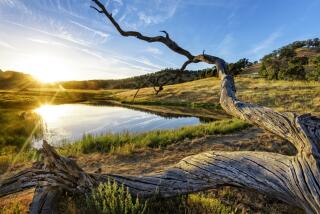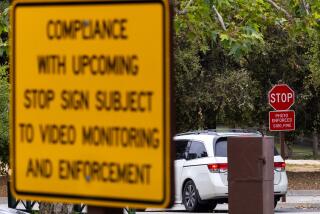Water Scooters May Be Sinking in National Parks
For those of us who hop aboard and loudly skitter across lakes, bays and rivers, Jet Skis are clearly great fun. Otherwise, we wouldnât buy 175,000 of them, WaveRunners and other water scooter brands every year.
But among the rest of us--including more than 35,000 who recently wrote anti-water-scooter letters to the National Park Service--the waterâs edge is a place to look for peace and quiet, or at least a big fish. In those quarters, sentiment has been building against the grown-up toys that are generically known as âpersonal watercraft.â (Jet Ski is owned by Kawasaki, WaveRunner by Yamaha.)
Noise, danger, air and water pollution--all are cited in arguments against the devices. And two new moves by public officials have broadened the battle over their use on public lands.
The first came at Lake Tahoe, where summer weekends in recent years have seen scores of water scooters at play. Since June 1, authorities on the lakeâs California and Nevada shores have forbidden most water scooters because of the petroleum waste that their two-stroke engines leave behind.
The second move, a proposed policy change nearing final approval in Washington, would install a new set of national park rules banning the vehicles from all but about two dozen park service sites. At some of those excepted sites, including several national recreation areas where use of the vessels has grown dramatically, superintendents will retain the right to allow or disallow water scooters. At others, the park service is allowing a two-year âgraceâ period while it decides whether to further extend the ban.
The five companies that make most of the water scooters in the U.S., which together sponsor the Personal Watercraft Industry Assn. in Washington, say theyâre working hard to make their craft cleaner and quieter. Instead of bans, they argue for government regulations that balance the interests of boaters with others. Occasionally the group files lawsuits to block restrictions and to press its cause, and it has many allies.
Annual sales of the craft have tripled since 1988, despite an average price tag of about $6,450. National races are staged at Lake Havasu in Arizona. Special areas for the craft are set aside in Daytona Beach, Fla. Though state air-quality officials last year backed a gradual move to stiffer emissions limits, Californiaâs state park system, which includes the popular recreational waters at Perris, Silverwood, Oroville and Folsom lakes, regulates the use of all vessels, and has no water scooter ban in the works.
Still, a spokesman said, âwhat happens with the National Park Service may help determine what happens with us in the future.â
Anti-scooter sentiment is strong. The Sierra Club, which backs tighter regulation of two-stroke engines wherever it can, claims that in seven hours of operation a standard water scooterâs two-stroke engine belches as much air pollution as a 1998 automobile will emit in 100,000 miles. The Izaak Walton League of America, a national conservation organization, asserts that two-stroke engines leak 165 million gallons of oil into Americaâs waters each year--15 times the amount released by the Exxon Valdez in its 1989 spill.
The league also reports that water scooters, which commonly reach speeds of 50 mph, make up only 9% of all registered boats but are involved in 46% of boating injuries.
At the famously clear Lake Tahoe, local officials say, visibility from the surface to the depths has dwindled from more than 100 feet to less than 70 over the last three decades as recreational uses have increased. The average water scooterâs engine, opponents say, discharges 25% to 30% of its fuel, unburned, into the water or air.
The Tahoe Regional Planning Agency spent three years assembling its ban amid fierce arguments on each side. The final version bars older, more wasteful water scooters--and all other craft with similar engines--but permits newer (and pricier) models with fuel-injection engines that dramatically reduce waste.
âAs new technology becomes available on Jet Skis, theyâre going to be back,â says Pam Drum, spokeswoman for the Tahoe Regional Planning Authority.
The park serviceâs actions in Washington may leave a broader wake than the Tahoe restrictions. Though several parks, including Everglades, Yellowstone and the Grand Canyon, have imposed their own bans on the machines, this would be the first system-wide prohibition. If park service officials have their way, the machines will be banned from 356 of the 378 units in the national park system.
The National Park Service endorsed the move in May, but the rules still need formal backing from the Secretary of the Interior and the Office of Management and Budget. A park service spokesman said officials are âcautiously optimisticâ that the rules will be enacted before next summer--perhaps as soon as this fall.
The proposed rules leave superintendents to decide park by park whether to permit the scooters at 13 sites, most notably Lake Mead (bordered by Nevada and Arizona) and Glen Canyon (bordered by Arizona and Utah) recreation areas. Both Lake Mead and Glen Canyon, officials note, are largely man-made attractions that have allowed water sports since their creation.
One national park targeted for an outright ban is Channel Islands, where rangers report âextremely lowâ usage of the vehicles.
At Olympic National Park in Washington, another park included in the ban proposal, superintendent Dave Morris has already put a scooter prohibition in place at Lake Crescent through the parkâs local planning process.
During the five-month comment period leading up to the October move, Morris said, the park got 2,000 responses, split between those who wanted an outright ban and those who wanted minimal restrictions. But now that the rule is in effect, he added, his rangers havenât had to write a single citation. He has also honed his answer for those who challenge the ban.
âRollerblading is good,â Morris says. âChurch is good. But Rollerblading in church is not good. A national park is a special place.â
*
Christopher Reynolds welcomes comments and suggestions, but cannot respond individually to letters and calls. Write Travel Insider, Los Angeles Times, Times Mirror Square, Los Angeles 90053, or send e-mail to [email protected].
More to Read
Sign up for The Wild
Weâll help you find the best places to hike, bike and run, as well as the perfect silent spots for meditation and yoga.
You may occasionally receive promotional content from the Los Angeles Times.







